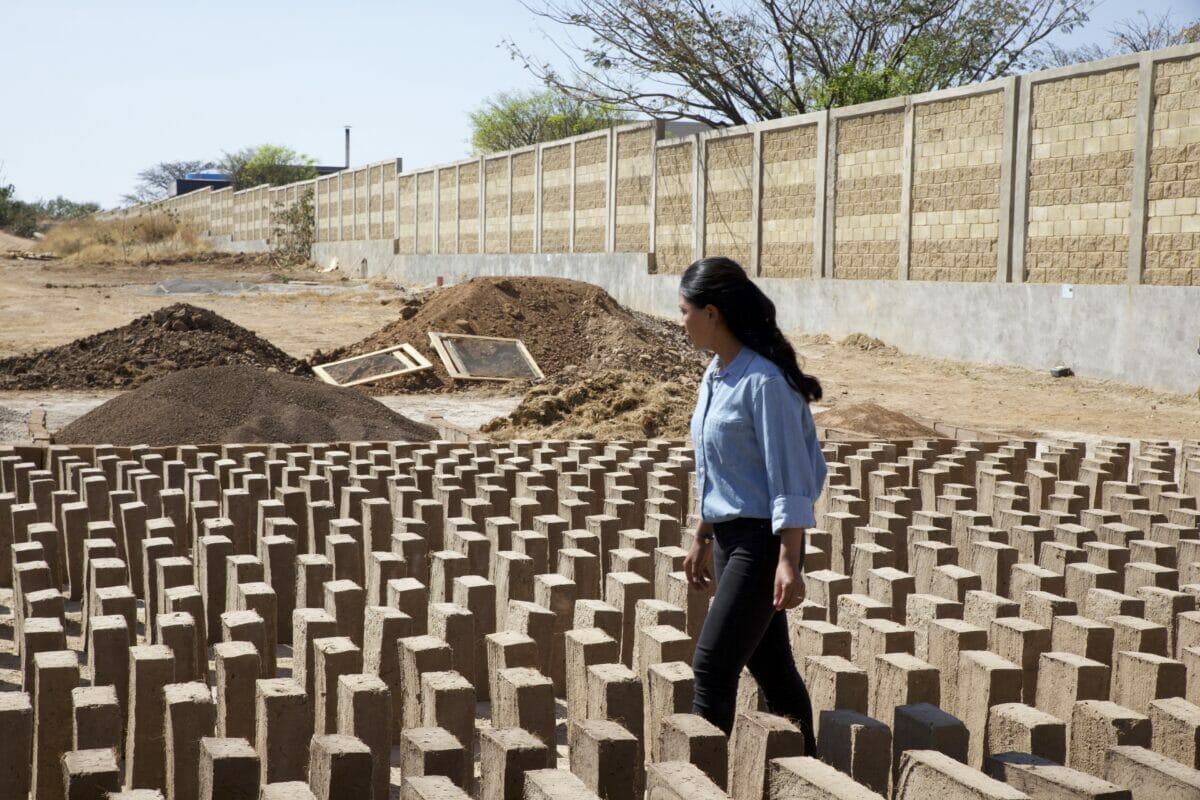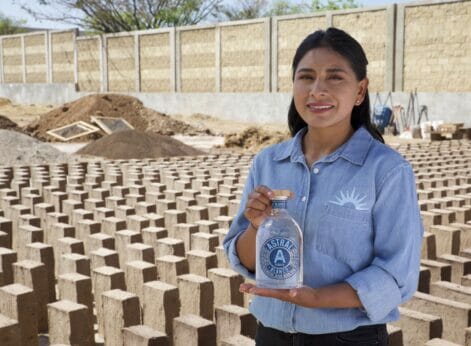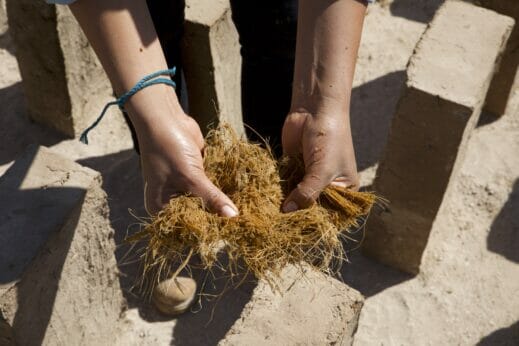Martha Jimenez Cardoso is using byproducts from tequila distillation to put a sustainable twist on traditional adobe.

Oaxacan engineer Martha Jimenez Cardoso comes from a farming family. “For us, corn is like gold,” she says. Her mother still plants this ancient crop with a stick and a few kernels, the way the people in her small Indigenous village of Santa Maria Tlahuitoltepec Mixe have done for 12,000 years.
Cardoso’s agricultural roots taught her to value and respect nature. Without Mother Earth, says Cardoso, “we have nothing.” She transformed this cultural imperative into a career that not only cares for the planet but helps people along the way. As director of sustainability at Astral Tequila, she takes the waste created during the tequila distillation process and repurposes it into adobe-style bricks. The bricks are then donated to build homes for people in the surrounding communities, nearly half of whom live below the poverty line.

Martha Jimenez Cardoso, pictured with a bottle of Astral Tequila. Each bottle produced helps to make approximately two bricks. (Photo courtesy of Astral Tequila)
Tequila waste is abundant. One standard .75-liter bottle of tequila produces more than 11 pounds of bagasse (the fibrous remnants of the agave piña after steaming, crushing and fermenting) and around 10 liters of vinasse (the liquid runoff of the distillation process). In 2016, the Tequila Regulatory Council estimated that the industry generates more than 4.7 million tons of bagasse and 2.5 billion liters of vinasse annually. That looming figure has only grown with a global thirst for this Mexican spirit. As the second most popular liquor in the world, tequila is a $10-billion industry that exports to more than 170 countries. Market experts predict international demand to expand to more than $15 billion before the end of the decade.
Because bagasse is comprised mainly of cellulose and lignin, it can be repurposed into a number of valuable items, including construction materials, fertilizer, paper, wooden crafts, biofuels and even prebiotic dietary fiber. But many tequila companies simply compost the bagasse or toss it into landfills where it off-gasses methane. Vinasse, on the other hand, doesn’t have nearly the versatility of its cohort. Although environmental regulations from the 1990s require the run-off to be treated, the vast majority of vinasse is not. Most of the liquid winds up in nearby bodies of water or farming fields where its low-pH and high temperatures can cause damage.
Cardoso helped pioneer a solution to combine soil with the leftover bagasse and vinasse from agave spirits distillation to create an ancient building material known as adobe. Along with her team at Green Loop, a raw material and energy solutions company specializing in recycling agave fibers, Cardoso oversees the Adobe Brick Project, the sustainability arm of Astral Tequila. The project has made thousands of bricks, donating them to new housing construction and improvement projects while collaborating with local builders and architects.

Bagasse is the fibrous waste from the agave plant. (Photo courtesy of Astral Tequila)
The adobe bricks not only repurpose tequila waste, but they’re also an excellent construction material for the warm, temperate climate in Mexico. Because of its high thermal mass, adobe stays cool during the day and releases heat at night, producing less waste, consuming less energy and creating a lower environmental impact than mainstream building materials. The more local the supplies to make the adobe, the smaller the carbon footprint. Plus, adobe buildings are remarkably resilient and can stand for centuries with regular maintenance.
For Cardoso, using her skills to benefit the community and upcycle food waste fulfills a lifelong dream. A graduate of the Oaxaca University of Technology with a degree in civil engineering, she credits her family for inspiring her intrepid path. Her father, a farmer and construction worker, enthralled young Cardoso with stories about the projects on which he worked. When one of her older brothers decided to study engineering in college, she took great interest in what he was learning. Cardoso realized that if she followed in her brother’s footsteps, she too could carry out quality projects and help even more people.
“The most important thing is to be surrounded by people with the same goal of helping by doing their part to make dreams possible together,” says Cardoso. “Sustainability is a topic that is very important not only to me but also for many people who seek to reduce the impact on the environment, and it is a joy to know that I do two things that I like in the same project.”
In searching for a way to unite her passions, Cardoso learned from connections in Oaxaca that tequila waste could be used for a sustainable twist on traditional adobe. She immediately began assembling a team of experts on waste and soil to help her develop the agave upcycling process she continues to use today. “It was just a matter of teamwork and continuous testing to provide a good quality product that helps create homes for the families who really need it,” she says.
Cardoso first began repurposing agave byproducts from Astral Tequila’s sister brand, Sombra Mezcal, in 2017. When Astral was acquired and reintroduced in January 2022, Cardoso and her team began working with the tequila company, then headquartered in Guadalajara. The Adobe Brick Project currently operates in Jalisco, near Astral’s state-of-the-art distillery in Amatitán, where agave from five regions in Mexico is processed. Each change in geography created its own unique set of engineering challenges. Explains Cardoso, “It was a path of many lessons since the land in each place is different, and the waste is, too.”
To make the bricks, a machine combines the bagasse, vinasse and soil into heavy, wet adobe mud. A team of local employees then hand-packs the still-wet adobe into wooden molds that are left outside in the elements for ten days to cure—no oven, kiln or carbon emissions required. As the mud shrinks and dries, the agave fibers provide reinforcement for the brick. Multiple bricks can easily be mortared together using more mud. Each bottle of Astral Tequila helps make approximately two bricks, each measuring roughly 16 inches long, 8 inches wide and 4 inches tall. The project assembles around 300 bricks a day.
Later this year, the Adobe Brick Project will work with Hábitat para la Humanidad and Green Loop to provide bricks and other necessary construction materials for ten new homes and community spaces in the local municipality of Gómez Farias, Jalisco. Building structures for families facing housing insecurity and homelessness gives Cardoso great personal satisfaction. “When you come from a low-income family,” she explains, “you know what the deficiencies are and how difficult it is to have a decent home.” To see the big smiles on the faces of the families when a project is complete, she says, “that inspires me.”
Correction: A previous version of this story stated that the adobe is mixed with a mechanical tahona. The tahona is used to crush agave for tequila.
Wonderful! This is the type of innovation we need from future farmers. And all from the best spirit in the world!
As a fellow engineer, I admire and salute you and your accomplishments. You are a roll model.
Could this material be formulated to used in 3D printed housing?
Is there anything toxic in the vinasse byproduct?
How does this affect the”Billion Agave Project”?
http://www.combustionorganica.com visita nuestra pagina, edgar@combustionorganica.com, biomasa de bagazo de agave